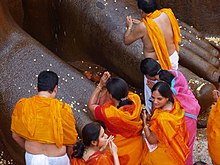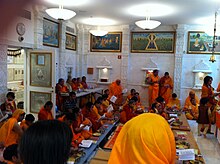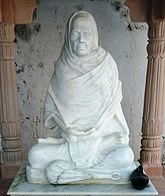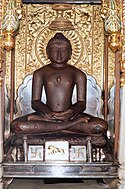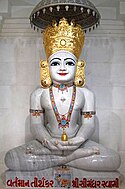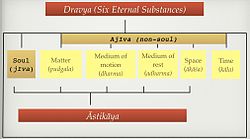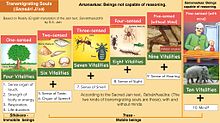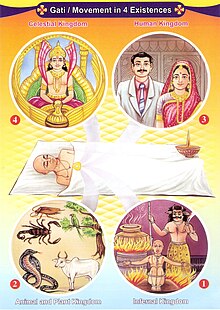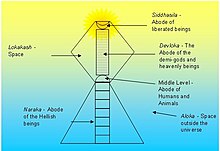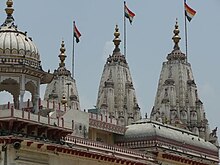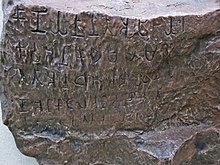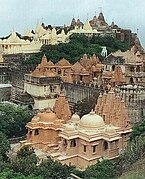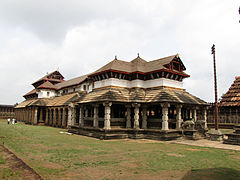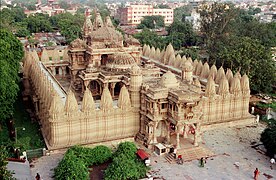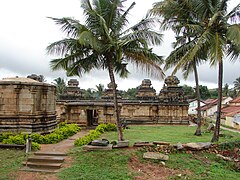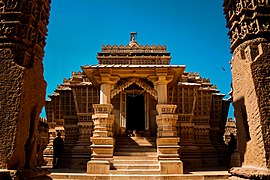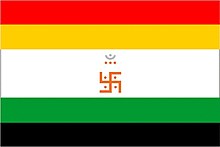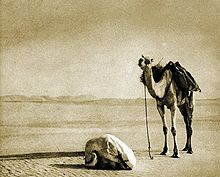Rishabhdev, believed to have lived over a million years ago, is considered the founder of Jain philosophy for this cosmic age.
Jainism (/ˈdʒeɪnɪzəm/), traditionally known as Jain Dharma, is an ancient Indian religion. Followers of Jainism are called "Jains", a word derived from the Sanskrit word jina (victory) and connoting the path of victory in crossing over life's stream of rebirths through an ethical and spiritual life. Jains trace their history through a succession of twenty-four victorious saviours and teachers known as tirthankaras, with the first being Rishabhanatha, who is believed to have lived millions of years ago in Jain tradition, and twenty-fourth being the Mahāvīra around 500 BCE. Jains believe that Jainism is an eternal dharma with the tirthankaras guiding every cycle of the Jain cosmology.
The main religious premises of Jainism are ahiṃsā ("non-violence"), anekāntavāda ("many-sidedness"), aparigraha ("non-attachment") and asceticism. Jain monastics, renunciants, and devout householders take five main vows known as vratas, outlined in their oldest surviving text, the Acaranga Sūtra: ahiṃsā ("non-violence"), satya ("truth"), asteya ("not stealing"), brahmacharya ("celibacy or chastity"), and aparigraha ("non-attachment"). These principles have impacted Jain culture in many ways, such as leading to a predominantly vegetarian lifestyle that avoids harm to animals and their life cycles. Parasparopagraho Jīvānām ("the function of souls is to help one another") is the motto of Jainism. Ṇamōkāra mantra is the most common and basic prayer in Jainism.
Jainism has two major ancient sub-traditions, Digambaras and Śvētāmbaras; and several smaller sub-traditions that emerged in the 2nd millennium CE. The Digambaras and Śvētāmbaras have different views on ascetic practices, gender and which Jain texts can be considered canonical. Jain mendicants are found in all Jain sub-traditions, with laypersons (śrāvakas) supporting the mendicants' spiritual pursuits with resources.
Jainism has between four and five million followers, with most Jains residing in India. Outside India, some of the largest Jain communities are present in Canada, Europe, Kenya, the United Kingdom, Hong Kong, Suriname, Fiji, and the United States. Major Jain festivals include Paryushana and Daslakshana, Mahavir Jayanti, and Diwali.
Main principles
Non-violence (ahimsa)
Painting with the message Ahiṃsā Paramo Dharma ("non-violence is the highest virtue or religion")
The hand with a wheel on the palm symbolizes Ahiṃsā in Jainism. The word in the middle is ahiṃsā. The wheel represents the dharmachakra, which stands for the resolve to halt the saṃsāra ('transmigration') through relentless pursuit of truth and non-violence.
The principle of ahimsa("non-violence" or "non-injury") is a fundamental tenet of Jainism. It believes that one must abandon all violent activity, and without such a commitment to non-violence all religious behavior is worthless. In Jain theology, it does not matter how correct or defensible the violence may be, one must not kill any being, and "non-violence is one's highest religious duty".
Jain texts such as Acaranga Sūtra and Tattvarthasūtra state that one must renounce all killing of living beings, whether tiny or large, movable or immovable. Its theology teaches that one must neither kill another living being, nor cause another to kill, nor consent to any killing directly or indirectly. Furthermore, Jainism emphasizes non-violence against all beings not only in action but also in speech and in thought. It states that instead of hate or violence against anyone, "all living creatures must help each other". Violence negatively affects and destroys one's soul, particularly when the violence is done with intent, hate or carelessness, or when one indirectly causes or consents to the killing of a human or non-human living being.
The idea of reverence for non-violence (ahiṃsā) is founded in Hindu and Buddhist canonical texts, and it may have origins in more ancient Brahmanical Vedic thoughts. However, no other Indian religion has developed the non-violence doctrine and its implications on everyday life as has Jainism.
The theological basis of non-violence as the highest religious duty has been interpreted by some Jain scholars not to "be driven by merit from giving or compassion to other creatures, nor a duty to rescue all creatures", but resulting from "continual self-discipline", a cleansing of the soul that leads to one's own spiritual development which ultimately affects one's salvation and release from rebirths. Causing injury to any being in any form creates bad karma which affects one's rebirth, future well being and suffering.
Late medieval Jain scholars re-examined the Ahiṃsā doctrine when one is faced with external threat or violence. For example, they justified violence by monks to protect nuns. According to Dundas, the Jain scholar Jinadatta Suri wrote during a time of Muslim destruction of temples and persecution that "anybody engaged in a religious activity who was forced to fight and kill somebody would not lose any spiritual merit but instead attain deliverance". However, such examples in Jain texts that condone fighting and killing under certain circumstances are relatively rare.
Many-sided reality (anekāntavāda)
The second main principle of Jainism is anekāntavāda or anekantatva, a word derived from anekānta ("not one ended, sided", "many-sidedness" or "manifoldness") and vada ("doctrine", "way").The anekāntavāda doctrine states that truth and reality is complex and always has multiple aspects. Reality can be experienced, but it is not possible to totally express it with language. Human attempts to communicate is Naya, explained as "partial expression of the truth". Language is not Truth, but a means and attempt to express Truth. From Truth, according to Mahāvīra, language returns and not the other way round. One can experience the truth of a taste, but cannot fully express that taste through language. Any attempts to express the experience is syāt, or valid "in some respect" but it remains a "perhaps, just one perspective, incomplete". In the same way, spiritual truths are complex, they have multiple aspects, and language cannot express their plurality, yet through effort and appropriate karma they can be experienced. Since reality is many-sided the great error, according to Jainism, is ekānta (one-sidedness) where some relative truth is treated as an absolute truth to the exclusion of others.
The anekāntavāda premise of the Jains is ancient, as evidenced by its mention in Buddhist texts such as the Samaññaphala Sutta. The Jain Agamas suggest that Mahāvīra's approach to answering all metaphysical philosophical questions was a "qualified yes" (syāt). These texts identify anekāntavāda doctrine to be one of the key differences between the teachings of the Mahāvīra and those of the Buddha. The Buddha taught the Middle Way, rejecting extremes of the answer "it is" or "it is not" to metaphysical questions. The Mahāvīra, in contrast, taught his followers to accept both "it is", and "it is not", with "perhaps" qualification and with reconciliation to understand the Absolute Reality. Syādvāda (predication logic) and nayavāda (perspective epistemology) of Jainism expand on the concept of anekāntavāda. Syādvāda recommends the expression of anekānta by prefixing the epithet syād to every phrase or expression describing the "permanent being". There is no creator God in Jainism; existence has neither beginning nor end, and the permanent being is conceptualized as jiva ("soul") and ajiva ("matter") within a dualistic anekāntavāda framework.
According to Paul Dundas, in contemporary times the anekāntavāda doctrine has been interpreted by many Jains as intending to "promote a universal religious tolerance", and a teaching of "plurality" and "benign attitude to other [ethical, religious] positions". Dundas states this is problematic and a misreading of Jain historical texts and Mahāvīra's teachings. The "many pointedness, multiple perspective" teachings of the Mahāvīra is a doctrine about the nature of absolute reality and human existence, and it is sometimes called "non-absolutism" doctrine. However, it is not a doctrine about tolerating or condoning activities such as sacrificing or killing animals for food, nor violence against disbelievers or any other living being as "perhaps right". The five vows for Jain monks and nuns, for example, are strict requirements and there is no "perhaps" or "that is just one perspective" about them. Similarly, since ancient times, Jainism co-existed with Buddhism and Hinduism according to Dundas, but Jainism was highly critical of the knowledge systems and ideologies of its rivals, and vice versa.
Non-attachment (aparigraha)
The third main principle in Jainism is aparigraha which means non-attachment to worldly possessions. For ascetics, Jainism requires a vow of complete non-possession of any property. For Jain laypersons, it recommends limited possession of property that has been honestly earned, and giving excess property to charity. According to Natubhai Shah, aparigraha applies to both the material and the psychic. Material possessions refer to various forms of property. Psychic possessions refer to emotions, likes and dislikes, and attachments of any form. Unchecked attachment to possessions is said to result in direct harm to one's personality.
Jainism views attachments to material or emotional possessions as what leads to passions, which in turn leads to violence. According to the aparigraha principle, a Jain monk or nun is expected to be homeless and family-less with no emotional longings or attachments. The ascetic is a wandering mendicant in the Digambara tradition, or a resident mendicant in the Śvētāmbara tradition.
In addition, Jain texts mention that "attachment to possessions" (parigraha) is of two kinds: attachment to internal possessions (ābhyantara parigraha), and attachment to external possessions (bāhya parigraha). For internal possessions, Jainism identifies four key passions of the mind (kashaya): anger, pride (ego), deceitfulness, and greed. In addition to the four passions of the mind, the remaining ten internal passions are: wrong belief, the three sex-passions (male sex-passion, female sex-passion, neuter sex-passion), and the six defects (laughter, like, dislike, sorrow, fear, disgust).
Jain ethics and five vows
Nishidhi stone, depicting the vow of sallekhana, 14th century, Karnataka
Jainism teaches five ethical duties, which it calls five vows. These are called anuvratas ("small vows") for Jain laypersons, and mahavratas ("great vows") for Jain mendicants. For both, its moral precepts preface that the Jain has access to a guru ("teacher", "counsellor"), deva ("Jina", "god"), doctrine, and that the individual is free from five offences: doubts about the faith, indecisiveness about the truths of Jainism, sincere desire for Jain teachings, recognition of fellow Jains, and admiration for their spiritual pursuits. Such a person undertakes the following Five vows of Jainism:
- Ahiṃsā, "intentional non-violence" or "noninjury": The first major vow taken by Jains is to cause no harm to other human beings, as well as all living beings.
This is the highest ethical duty in Jainism, and it applies not only to
one's actions, but demands that one be non-violent in one's speech and
thoughts.
- Satya,
"truth": This vow is to always speak the truth. Neither lie, nor speak
what is not true, and do not encourage others or approve anyone who
speaks an untruth.
- Asteya, "not stealing": A Jain layperson should not take anything that is not willingly given. Additionally, a Jain mendicant should ask for permission to take it if something is being given.
- Brahmacharya,
"celibacy": Abstinence from sex and sensual pleasures is prescribed for
Jain monks and nuns. For laypersons, the vow means chastity,
faithfulness to one's partner.
- Aparigraha, "non-possessiveness": This includes non-attachment to material and psychological possessions, avoiding craving and greed. Jain monks and nuns completely renounce property and social relations, own nothing and are attached to no one.
Practices
Asceticism
Of all the major Indian religions, Jainism has had the strongest austerity-driven ascetic tradition, and it is an essential part of a mendicant's spiritual pursuits. Ascetic life may include nakedness symbolizing non-possession of even clothes, fasting, body mortification, penance, and other austerities, in order to burn away past karma and stop producing new karma, both of which are believed in Jainism to be essential for reaching siddha and moksha ("liberation from rebirths", and "salvation").Jain texts like Tattvartha Sūtra and Uttaradhyayana Sūtra discuss ascetic austerities to great lengths and formulations. Six outer and six inner practices are most common, and oft-repeated in later Jain texts. According to John Cort, outer austerities include complete fasting, eating limited amounts, eating restricted items, abstaining from tasty foods, mortifying the flesh, and guarding the flesh (avoiding anything that is a source of temptation). Inner austerities include expiation, confession, respecting and assisting mendicants, studying, meditation, and ignoring bodily wants in order to abandon the body.
Lists of internal and external austerities in Jainism varies with the text and tradition. Asceticism is viewed as a means to control desires, and a means to purify the jiva ("soul"). The tirthankaras of Jainism, such as the Mahāvīra (Vardhamana) set an example of leading an ascetic life by performing severe austerities for twelve years.
Food and fasting
The practice of non-violence towards all living beings has led to Jain culture being vegetarian, while veganism is encouraged. Most Jains practice lacto-vegetarianism (no eggs, but dairy products permitted if no violence is used during the production). Jain monks and nuns do not eat root vegetables such as potatoes, onions and garlic because tiny organisms are injured when the plant is pulled up, and because a bulb or tuber's ability to sprout is seen as characteristic of a higher living being.Jains fast on different occasions throughout the year, particularly during festivals. This practice is called upavasa, tapasya or vrata. According to Singh, this takes on various forms and may be practised based on one's ability. Some examples include Digambara fasting for Dasa-laksana-parvan where a Jain layperson eats only one or two meals per day, drinking only boiled water for ten days, or fasting completely on the first and last day of the festival. With these practices the layperson mimics the practices of a Jain mendicant during the festival. A similar practice is found among Śvētāmbara Jains on eight day paryusana with samvatsari-pratikramana.
The fasting practice is believed to remove karma from one's soul and allow one to gain merit (punya). A "one day" fast in Jain tradition lasts about 36 hours, starting at sunset before the day of the fast and ending 48 minutes after the sunrise the day after. Among laypeople, fasting is more commonly observed by women, where it is believed that this shows her piety, religious purity, gains her and her family prestige, leads to merit earning and helps ensure future well-being for her family. Some religious fasts are observed as a group where Jain women bond socially and support each other. Long fasts are celebrated by friends and families with special ceremonies.
Meditation
Left: Jain nuns meditating, Right: 10th century Gommateshwara statue depicting standing meditation (Kayotsarga posture)
Jainism considers meditation (dhyana) a necessary practice, but its goals are very different from those in Buddhism and Hinduism. In Jainism, meditation is concerned more with stopping karmic attachments and activity, not as a means to transformational insights or self-realization in other Indian religions. Meditation in early Jain literature is a form of austerity and ascetic practice in Jainism, while in late medieval era the practice adopted ideas from other Indian traditions. According to Paul Dundas, this lack of meditative practices in early Jain texts may be because substantial portions of ancient Jain texts were lost.
According to Padmanabh Jaini, Sāmāyika is a practice of "brief periods in meditation" in Jainism that is a part of siksavrata ("ritual restraint"). The goal of Sāmāyika is to achieve equanimity, and it is the second siksavrata. The samayika ritual is practiced at least three times a day by mendicants, while a layperson includes it with other ritual practices such as Puja in a Jain temple and doing charity work. According to Johnson, as well as Jaini, samayika connotes more than meditation, and for a Jain householder is the voluntary ritual practice of "assuming temporary ascetic status".
The Digambara Jain scholar Kundakunda, in his Pravacanasara states that a Jain mendicant should meditate on "I, the pure self". Anyone who considers his body or possessions as "I am this, this is mine" is on the wrong road, while one who meditates, thinking the antithesis and "I am not others, they are not mine, I am one knowledge" is on the right road to meditating on the "soul, the pure self".
Rituals and worship
Praying at the feet of a statue of Bahubali
There are many rituals in Jainism's various sects. According to Dundas, the ritualistic lay path among Śvētāmbara Jains is "heavily imbued with ascetic values", where the rituals either revere or celebrate the ascetic life of Tirthankaras, or mendicants, or progressively get closer to psychologically and physically living ever more like an ascetic. The ultimate ritual is sallekhana, a religious death through ascetic abandonment of food and drinks. The Digambara Jains follow the same theme, but the details differ from Śvētāmbaras, and according to Dundas, the life cycle and religious rituals are closer to the liturgy found among Hindu traditions. The overlap in Jain and Hindu rituals is largely in the life cycle (rites-of-passage) rituals, according to Padmanabh Jaini, and likely one that developed over time because Jains and Hindus societies overlapped, and rituals were viewed as necessary and secular ceremonies.
Jains do not believe in a creator god, but do ritually worship numerous deities. The Jinas are prominent and a large focus of this ritualism, but they are not the only deva in Jainism. A Jina as deva is not an avatar (incarnation) in Jainism, but the highest state of omniscience that an ascetic tirthankara achieved. Out of the 24 Tirthankaras, Jain devotional worship is predominantly centered around four: Mahāvīra, Parshvanatha, Neminatha and Rishabhanatha. Among the non-tirthankara saints, devotional worship is common for Bahubali among the Digambaras. Some of Jaina rituals remember the five life events of the tirthankaras, called the Panch Kalyanaka, are rituals such as the Panch Kalyanaka Pratishtha Mahotsava, Panch Kalyanaka Puja and Snatrapuja.
Jain worship may include ritual offerings and recitals.
Jain practices include performing abhisheka ("ceremonial bath") of the images. Some Jain sects employ a pujari (also called upadhye) for rituals, who may be a non-Jain (a Hindu), to perform special rituals and other priestly duties at the temple. More elaborate worship includes ritual offerings such as rice, fresh and dry fruits, flowers, coconut, sweets, and money. Some may light up a lamp with camphor and make auspicious marks with sandalwood paste. Devotees also recite Jain texts, particularly the life stories of the tirthankaras.
The traditional Jains, like Buddhists and Hindus, believe in the efficacy of mantras and that certain sounds and words are inherently auspicious, powerful and spiritual. The most famous of the mantras, broadly accepted in various sects of Jainism, is the "five homage" (panca namaskara) mantra which is believed to be eternal and existent since the first ford-maker's time. The medieval era Jain worship practices, according to Ellen Gough, also developed tantric diagrams of the Rishi-mandala where the tirthankaras are portrayed. The Tantric traditions within Jainism use mantra and rituals that are believed to accrue merit for rebirth realms.
Festivals
Celebrating Das Lakshana (Paryusana), Jain Center of America, New York City
Jains celebrate many annual festivals. Many of the major festivals in Jainism fall in and around the comasu (Sanskrit: chaturmasa) period of the calendar. It is the four-month monsoon period when the Jain ascetics are mandated to remain in residence at one place in the Jain tradition, rather than traveling or going around Indian villages and towns for religion reformations but never staying in one place for more than a month. The comasu period allows the four orders of the Jain community to be together and participate in the festive remembrances.
The most important annual Jain festival is called the Paryushana by Śvētāmbaras and Dasa lakshana parva by the Digambaras. It is celebrated from the 12th day of waning moon in the traditional luni-solar month of Bhadrapada in the Indian calendar. This typically falls in August or September of the Gregorian calendar. It lasts eight days for Śvētāmbaras, and ten days among the Digambaras. It is a time when lay people fast and pray. The five vows are emphasized during this time. Śvētāmbaras recite the Kalpasūtras, while Digambaras read their own texts. The festival is an occasion where Jains make active effort to stop cruelty towards other life forms, freeing animals in captivity and preventing slaughter of animals.
Forgiveness
—Jain festival prayer on the last day
I forgive all living beings,
may all living beings forgive me.
All in this world are my friends,
I have no enemies.
may all living beings forgive me.
All in this world are my friends,
I have no enemies.
The last day involves a focused prayer/meditation session known as Samvatsari. Jains consider this as a day of atonement, granting forgiveness to others, seeking forgiveness from all living beings, physically or mentally asking for forgiveness and resolving to treat everyone in the world as friends. Forgiveness is asked by saying "Micchami Dukkadam" or "Khamat Khamna" to others. This means, "If I have offended you in any way, knowingly or unknowingly, in thought, word or action, then I seek your forgiveness." The literal meaning of Paryushana is "abiding" or "coming together".
Mahavir Jayanti celebrates the birth of Mahāvīra. It is celebrated on the 13th day of the luni-solar month of Chaitra in the traditional Indian calendar. This typically falls in March or April of the Gregorian calendar. The festivities include visiting Jain temples, pilgrimages to shrines, reading Jain texts and processions of Mahāvīra by the community. At his legendary birthplace of Kundagrama in Bihar, north of Patna, special events are held by Jains.
Diwali is observed by Jains as the anniversary of Mahāvīra's attainment of moksha. The Hindu festival of Diwali is also celebrated on the same date (Kartika Amavasya). Jain temples, homes, offices, and shops are decorated with lights and diyas ("small oil lamps"). The lights are symbolic of knowledge or removal of ignorance. Sweets are often distributed. On Diwali morning, Nirvan Ladoo is offered after praying to Mahāvīra in all Jain temples across the world. The Jain new year starts right after Diwali. Some other festivals celebrated by Jains are Akshaya Tritiya and Raksha Bandhan, similar to those in the Hindu communities.
Monasticism
Jainism monastic organization is a part of Jain society called sangh. A sangh has a four-fold order, or caturvidh, sakal sangh. This consists of sadhu (male ascetics, muni), sadhvi (female ascetics, aryika), śrāvaka ("laymen"), and śrāvikā ("laywoman"). The latter two support the ascetics and their monastic organizations called gacch or samuday, in autonomous regional Jain congregations.
Digambar tradition has two main monastic orders Mula Sangh and the Kashtha Sangh, both led by Bhattarakas. Other notable monastic orders include the Digambara Terapanth which emerged in the 17th century.[119] Śvētāmbaras have their own sanghs, but unlike Digambaras which have had predominantly sadhu sanghs (male monastic organizations), they have major sadhu and sadhvi sanghs (monks and nuns).
According to Śvētāmbara Jain texts, from Kalpasūtras onwards, its monastic community has had more sadhvis than sadhus (female than male mendicants). In Tapa Gacch of the modern era, the ratio of sadhvis to sadhus (nuns to monks) is about 3.5 to 1. In contrast to Śvētāmbara, the Digambara sect monastic community has been predominantly male. In the Digambara tradition, a male human being is considered closest to the apex with the potential to achieve his soul's liberation from rebirths through asceticism. Women must gain karmic merit, to be reborn as man, and only then can they achieve spiritual liberation in the Digambara sect of Jainism. The Śvētāmbaras disagree with the Digambaras, believing that women can also achieve liberation from Saṃsāra through ascetic practices.
The Jain monastic organization shares many parallels with those found in Buddhist and Brahmanical-Hindu monasticism. They all have similar rules, hierarchical structure, practices such as not traveling during the four-month monsoon season and celibacy. According to William Johnston, this is not likely from mutual borrowing of ideas, but because these traditions emerged from the same ancient Indian monastic traditions that preceded the Buddha and the Mahāvīra. There are some differences. For example, the Jain and Hindu monastic community has been traditionally more mobile and had an itinerant lifestyle, while Buddhist monks have favored belonging to a sangha (monastery) and staying in its premises. Buddhist monastic rules forbid a monk to go outside without wearing the sangha's distinctive ruddy robe, or to use wooden bowls. In contrast, Jain monastic rules have either required no clothes (Digambara) or white (Śvētāmbara) and the use of wooden or empty gourd as the begging bowl. The Jain monastic rules have encouraged the use of mouth cover, as well as a broom to gently remove any insect that comes in their path.
Supplementary vows and Sallekhana
Jainism also prescribes seven supplementary vows which include three guņa vratas ("merit vows") and four śikşā vratas.The Sallekhana (or Santhara) vow is a "religious death" ritual vow observed at the end of life, historically by Jain monks and nuns, but rare in the modern age. In this vow, there is voluntary and gradual reduction of food and liquid intake to end one's life by choice and with dispassion. In Jainism this is believed to reduce negative karma that affects a soul's future rebirths.
Traditions and sects
Digambaras and Śvētāmbaras
The Jain community is divided into two major denominations, Digambara and Śvētāmbara. Monks of the Digambara ("sky-clad") tradition do not wear clothes. Female monastics of the Digambara sect wear unstitched plain white sarees and are referred to as Aryikas. Śvētāmbara ("white-clad") monastics, on the other hand, wear seamless white clothes.During Chandragupta Maurya's reign, Jain tradition states that Acharya Bhadrabahu predicted a twelve-year-long famine and moved to Karnataka with his disciples. Sthulabhadra, a pupil of Acharya Bhadrabahu, stayed in Magadha. Later, when followers of Acharya Bhadrabahu returned, they found those who had remained at Magadha had started wearing white clothes, which was unacceptable to the others who remained naked. This is how Jains believe the Digambara and Śvētāmbara schism began, with the former being naked while the latter wore white clothes. Digambara saw this as being opposed to the Jain tenets which, according to them, required complete nudity. In the 5th-century CE, the Council of Valabhi was organized by Śvētāmbara, which Digambara did not attend. At the council, the Śvētāmbara adopted the texts they had preserved as canonical scriptures, which Digambara have ever since rejected. This council solidified the historic schism between these two major traditions of Jainism. The earliest record of Digambara beliefs is contained in the Prakrit Suttapahuda of Kundakunda.
Digambara Mahāvīra iconography
Śvētāmbara Simandhar Swami iconography
Other than rejecting or accepting different ancient Jain texts, Digambaras and Śvētāmbara differ in other significant ways such as:
- Śvētāmbaras trace their practices and dress code to the teachings of Parshvanatha, the 23rd tirthankara, which they believe taught only Four restraints (a claim, scholars say are confirmed by the ancient Buddhist texts that discuss Jaina monastic life). Mahāvīra taught Five vows, which Digambara follow. The Digambara sect disagrees with the Śvētāmbara interpretations, and reject the theory of difference in Parshvanatha and Mahāvīra's teachings.
- Digambaras believe that both Parshvanatha and Mahāvīra remained unmarried, whereas Śvētāmbara believe the 23rd and 24th did indeed marry. According to the Śvētāmbara version, Parshva married Prabhavati, and Mahāvīra married Yashoda who bore him a daughter named Priyadarshana. The two sects also differ on the origin of Trishala, Mahāvīra's mother, as well as the details of Tirthankara's biographies such as how many auspicious dreams their mothers had when they were in the wombs.
- Digambara believe Rishabha, Vasupujya and Neminatha were the three tirthankaras who reached omniscience while in sitting posture and other tirthankaras were in standing ascetic posture. In contrast, Śvētāmbaras believe it was Rishabha, Nemi and Mahāvīra who were the three in sitting posture.
- Digambara monasticism rules are more rigid.
- Digambara iconography are plain, Śvētāmbara icons are decorated and colored to be more lifelike.
Other sub-traditions
Both of the major Jain traditions evolved into sub-traditions over time. For example, the devotional worship traditions of Śvētāmbara are referred to as Murti-pujakas, those who live in and around Jain temples became Deravasi or Mandira-margi. Those who avoid temples and pursue their spirituality at a designated monastic meeting place came to be known as Sthānakavāsī. About the 18th century, the Śvētāmbara and Digambara traditions saw an emergence of separate Terapanthi movements. Some scholars such as Malvaniya state that these ideas entered Jainism from an influence of Islam, while others such as Dundas state that these ideas, debates and movements can be traced in more ancient texts than the start of Islam.In the modern era, according to Flügel, new Jaina religious movements that are a "primarily devotional form of Jainism" have developed which resemble "Jain Mahayana" style devotionalism.
Gender and spiritual liberation
A male human being is considered closest to the apex with the potential to achieve liberation, particularly through asceticism. In the Digambara traditional belief, women must gain karmic merit, to be reborn as man, and only then can they achieve spiritual liberation. However, this view has been historically debated within Jainism and different Jaina sects have expressed different views, particularly the Śvētāmbara sect that believes that women too can achieve spiritual liberation from rebirths in Saṃsāra. The Śvētāmbaras state the 19th Tirthankara Māllīnātha was female. However, Digambara reject this, and worship Mallinatha as a male.Beliefs and philosophy
Dravya ("Substance")
Chart showing the classification of dravya and astikaya
The dravya in Jainism are fundamental entities, called astikaya (literally, "collection that exists").[164] They are believed to be eternal, and the ontological building blocks that constitute and explain all existence, whether perceived or not.
According to the Śvētāmbara tradition of Jainism, there are five eternal substances in existence: Soul (jiva), Matter (pudgala), Space (akasha), motion (Dharma) and rest (Adharma). To this list of five, the Digambara Jain tradition adds "Time" (kala) as the sixth eternal substance. In both traditions, the substance of space is conceptualized as "world space" (lokakasha) and "non-world space" (alokiakasha). Further, both soul and matter are considered as active ontological substances, while the rest are inactive. Another categorization found in Jain philosophy is jiva and ajiva, the latter being all dravya that is not jiva.
Jīva ("Soul"), Ajīva ("Non-Soul")
Jiva means "soul" in Jainism, and is also called jivatman. It is a core concept and the fundamental focus of the Jain theology. The soul is believed to be eternal, and a substance that undergoes constant modifications, in every life, after every rebirth of a living being. Jiva consists of pure consciousness in the Jain thought, has innate "free will" that causes it to act but is believed to be intangible and formless. It is the soul that experiences existence and gains knowledge, not mind nor body both believed to a heap of matter. Jain philosophy further believes that the soul is the mechanism of rebirth, and karma accumulation. It is the same size in all living beings, such as a human being, a tiny insect and a large elephant. Jiva is everywhere, filling and infused in every minuscule part of the entire loka (realm of existence), according to Jainism. The soul has the potential to reach omniscience and eternal bliss, and end the cycles of rebirth and associated suffering, which is the goal of Jain spirituality.The jiva is believed to rely on other dravya to function. The Jain philosophy completely separates body (matter) from the soul (consciousness). Souls reside in bodies and journey endlessly through saṃsāra (that is, realms of existence through cycles of rebirths and redeaths).
Jivas are believed to be of two types, stationary and mobile. Illustration of the former are plants, while moving jivas include examples such as human beings, animals, gods, hell beings and insects. Jivas are further classified in Jain philosophy by assigned number of senses which range from one sensory organ to five sensory organs. Inert world such as air, fire or clod of dirt, considered non-sensate in contemporary science, are asserted in historic texts of Jainism to be living and with sensory powers.
Ajiva consists of everything other than jiva. Life processes such as breath, means of knowledge such as language, all emotional and biological experiences such as pleasure and pain are all believed in Jainism to be made of pudgala ("matter"). These interact with tattva or reality to create, bind, destroy or unbind karma particles to the soul.
According to Dundas, Dharma as a metaphysical substance in Jain philosophy may be understood as "that which carries" instead of the literal sense of ordinary physical motion. Thus, dharma includes all verbal and mental activity, that contribute to karma and purification of the soul.
Tattva ("Reality")
The 7 Tattvas of Jain philosophy
Tattva connotes "Reality, Truth" in Jain philosophy, and is the framework for salvation. According to Digambara Jains, there are seven tattvas, while Śvētāmbaras believe in nine tattvas:
- The sentient (jiva, soul)
- The insentient (ajiva)
- The karmic influx (Āsrava) to the soul
- Good karma (punya, merits), found in the tattva theory of Śvētāmbara, but not of Digambaras
- Bad karma (papa, negatives), found in the tattva theory of Śvētāmbara, but not of Digambaras
- The bondage (Bandha) of karmic particles to the soul, thereby causing its change, which cumulatively determines the future rebirths
- The stoppage (Saṃvara) of karmic influx
- The dissociation and wiping away of past karmic particles (Nirjarā) from the soul
- The liberation (Moksha)
Soul and Karma
According to Jainism, the existence of "a bound and ever changing soul" is a self-evident truth, an axiom which does not need to be proven. There are numerous souls, but every one of them has three qualities (Guṇa): consciousness (caitanya, most important quality of soul), bliss (sukha) and vibrational energy (virya). The vibration draws karmic particles to the soul and creates bondages, but is also what adds merit or demerit to the soul.Karma, like in other Indian religions, connotes in Jainism the universal cause and effect law. However, it is envisioned as a material substance (subtle matter) that can bind to the soul, travel with the soul substance in bound form between rebirths, and affect the suffering and happiness experienced by the jiva in the lokas. Karma is also believed to obscure and obstruct the innate nature and striving of the soul, as well as its spiritual potential in the next rebirth.
The relationship between the soul and karma, states Padmanabh Jaini, can be explained with the analogy of gold. Like gold is always found mixed with impurities in its original state, Jainism holds that the soul is not pure at its origin but is always impure and defiled like natural gold. One can exert effort and purify gold, similarly, Jainism states that the defiled soul can be purified by proper refining methodology. Karma either defiles the soul further, or refines it to a cleaner state, and this affects future rebirths. Karma is thus an efficient cause (nimitta) in Jain philosophy, but not the material cause (upadana). The soul is believed to be the material cause.
Tirthankara-nama-karma is a special type of karma, bondage of which raises a soul to the supreme status of a tirthankara.
Classification of Saṃsāri Jīvas (transmigrating souls) in Jainism
Jain texts state that souls exist as "clothed with material bodies", where it entirely fills up the body. There are five types of bodies in the Jaina thought: earthly (e.g. most humans, animals and plants), metamorphic (e.g. gods, hell beings, fine matter, some animals and a few humans who can morph because of their perfections), transference type (e.g. good and pure substances realized by ascetics), fiery (e.g. heat that transforms or digests food), and karmic (the substrate where the karmic particles reside and which make the soul ever changing).
Jain philosophy further divides the earthly body by symmetry, number of sensory organs, vitalities (ayus), functional capabilities and whether one body hosts one soul or one body hosts many.Every living being has one to five senses, three balas (power of body, language and mind), respiration (inhalation and exhalation), and life-duration. All living beings, in every realm including the gods and hell beings, accrue and destroy eight types of karma according to the elaborate theories in Jain texts. Elaborate descriptions of the shape and function of the physical and metaphysical universe, and its constituents, are also provided in the Jain texts. All of these elaborate theories attempt to illustrate and consistently explain the Jain karma theory in a deeply moral framework, much like Buddhism and Hinduism but with significant differences in the details and assumptions.
Saṃsāra
The conceptual framework of the Saṃsāra doctrine differs between the Jainism traditions and other Indian religions. For instance, in Jaina traditions, soul (jiva) is accepted as a truth, as is assumed in the Hindu traditions. It is not assumed in the Buddhist traditions. However, Saṃsāra or the cycle of rebirths, has a definite beginning and end in Jainism. The Jaina theosophy, unlike Hindu and Buddhist theosophies, asserts that each soul passes through 8,400,000 birth-situations, as they circle through Saṃsāra. As the soul cycles, states Padmanabh Jaini, Jainism traditions believe that it goes through five types of bodies: earth bodies, water bodies, fire bodies, air bodies and vegetable lives. With all human and non-human activities, such as rainfall, agriculture, eating and even breathing, minuscule living beings are taking birth or dying, their souls are believed to be constantly changing bodies. Perturbing, harming or killing any life form, including any human being, is considered a sin in Jainism, with negative karmic effects.
Souls begin their journey in a primordial state, and exist in a state of consciousness continuum that is constantly evolving through Saṃsāra. Some evolve to a higher state; some regress asserts the Jaina theory, a movement that is driven by the karma. Further, Jaina traditions believe that there exist Abhavya ("incapable"), or a class of souls that can never attain moksha ("liberation"). The Abhavya state of soul is entered after an intentional and shockingly evil act. Jainism considers souls as pluralistic each in a karma-samsara cycle, and does not subscribe to Advaita-style ("not two") nondualism of Hinduism, or Advaya-style nondualism of Buddhism. A liberated soul in Jainism is one who has gone beyond Saṃsāra, is at the apex, is omniscient, remains there eternally, and is known as a Siddha.
Cosmology
Rebirth loka (realms of existence) in Jain cosmology.[215]
Jain texts propound that the universe consists of many eternal lokas ("realms of existence"). As in Buddhism and Hinduism, Jain cosmology believes both time and the universe are eternal without beginning and end, and that the universe is transient (impermanent in attributes) at the same time. The universe, body, matter and time are considered in Jain philosophy as separate from the soul (jiva or jivatman). Their interaction explains life, living, death and rebirth.
Division of time in Jain cosmology.
According to the Jain texts, the universe is divided into three parts, the upper, middle, and lower worlds, called respectively urdhva loka, madhya loka, and adho loka. As with the realms of existences, Kāla ("time") is without beginning and eternal; the cosmic wheel of time, called kālachakra, rotates ceaselessly. According to Jain texts, in this part of the universe, there are six periods of time within two aeons (ara), and in the first aeon the universe generates, and in the next it degenerates. Thus, the worldly cycle of time is divided into two parts or half-cycles, utsarpiṇī ("ascending") and avasarpiṇī ("descending"). Utsarpiṇī is a period of progressive prosperity, where happiness increases, while avasarpiṇī is a period of increasing sorrow and immorality. According to Jain cosmology, it is currently the fifth ara of avasarpiṇī (half time cycle of degeneration). The present age is one of sorrow and misery, of religious decline, where the height and shape of living beings shrink. Jain thought holds that after the sixth ara, the universe will be reawakened in the new cycle and the start of utsarpiṇī aras.
According to Jain texts, sixty-three illustrious beings, called śalākāpuruṣas, are born on this earth in every Dukhama-sukhamā ara. The Jain universal history is a compilation of the deeds of these illustrious persons. They comprise twenty-four Tīrthaṅkaras, twelve chakravartins, nine balabhadra, nine narayana, and nine pratinarayana.
A chakravartī is an emperor of the world and lord of the material realm. Though he possesses worldly power, he often finds his ambitions dwarfed by the vastness of the cosmos. Jain puranas give a list of twelve chakravartins ("universal monarchs"). They are golden in complexion One of the chakravartins mentioned in Jain scriptures is Bharata Chakravartin. Jain texts like Harivamsa Purana and Hindu Texts like Vishnu Purana state that Indian subcontinent came to be known as Bharata varsha in his memory.
There are nine sets of balabhadra, narayana, and pratinarayana. The balabhadra and narayana are brothers. Balabhadra are nonviolent heroes, narayana are violent heroes, and pratinarayana the villains. According to the legends, the narayana ultimately kill the pratinarayana. Of the nine balabhadra, eight attain liberation and the last goes to heaven. On death, the narayana go to hell because of their violent exploits, even if these were intended to uphold righteousness.
Jain cosmology divides the worldly cycle of time into two parts (avasarpiṇī and utsarpiṇī). According to Jain belief, in every half-cycle of time, twenty-four tīrthaṅkaras are born in the human realm to discover and teach the Jain doctrine appropriate for that era. The word tīrthankara signifies the founder of a tirtha, which means a fordable passage across a sea. The tīrthaṅkaras show the 'fordable path' across the sea of interminable births and deaths. Rishabhanatha is said to be the first tīrthankara of the present half-cycle (avasarpiṇī). Mahāvīra (6th century BC) is revered as the twenty fourth tīrthankara of avasarpiṇī. Jain texts explain that Jainism has always existed and will always exist.
In Jainism, perfect souls with the body are called arihant ("victors") and perfect souls without the body are called Siddhas ("liberated souls").
God
Jain miniature painting of 24 tirthankaras, Jaipur, c. 1850
According to Jainism, the universe was never created, nor will it ever cease to exist. It is independent and self-sufficient, does not require a creator nor any superior power to govern it, nor a judge nor destroyer. In this belief, it is distinct from the monotheistic Abrahamic religions; it is similar to Buddhism. It shares premises with the non-theistic part of the spectrum of diverse beliefs found in different traditions within Hindu philosophy and distinct from theistic Hindu traditions.
Jain texts reject the idea of a creator, ruler or destroyer god and postulate an eternal universe. However, Jainism believes in the world of gods and hell beings who are born, and who die to be reborn like living beings in the earthly realm of existence. Those souls who live in the body of a god do so because of their positive karma. They have a metamorphic body, that is they are believed in Jain thought to be able to change their body at will. The gods live a life of happiness, fun and frolic, whose wishes are automatically fulfilled. They also possess a more transcendent knowledge about material things and can anticipate events in the human realms. However, once their past karmic merit is exhausted, the souls leave the "god body" and are reborn again as humans, animals or other beings.
Epistemology
Jain philosophy accepts three reliable means of knowledge (pramana). It holds that correct knowledge is based on perception (pratyaksa), inference (anumana) and testimony (sabda or the word of scriptures). These ideas are elaborated in Jain texts such as Tattvarthasūtra, Parvacanasara, Nandi and Anuyogadvarini. Some Jain texts add analogy (upamana) as the fourth reliable means, in a manner similar to epistemological theories found in other Indian religions.In Jainism, jnāna ("knowledge") is said to be of five kinds—Kevala Jnana ("Omniscience"), Śrutu Jñāna ("Scriptural Knowledge"), Mati Jñāna ("Sensory Knowledge"), Avadhi Jñāna ("Clairvoyance"), and Manah prayāya Jñāna ("Telepathy"). According to the Jain text Tattvartha sūtra, the first two are indirect knowledge and the remaining three are direct knowledge.
Salvation, liberation
The three shikhar (top) of a Jain temple represents Ratnatraya (three jewels)
According to Jainism, purification of soul and liberation can be achieved through the path of three jewels:
- Samyak darśana ("Correct View") – Faith in basic tenets of Jainism, acceptance of the self-evident truth of soul (jīva)
- Samyak jnana ("Correct Knowledge") – Knowledge of the tattvas without any doubt or misapprehension
- Samyak charitra (Correct Conduct) – behavior consistent with the Five vows
Scriptures and texts
The Suryaprajnaptisūtra, a 4th or 3rd century BCE astronomy text of Śvētāmbara Jains. Above: its manuscript from c. 1500 CE.
Stela depicting Śhrut Jnāna, or complete scriptural knowledge
Jain scriptures are called Agamas. They are believed to have been verbally transmitted by the oral tradition from one generation to the next, much like the ancient Buddhist and Hindu texts. The Jain tradition believes that their religion is eternal, and the teachings of their first Tirthankara Rishabhanatha were their scriptures millions of years ago. The mythology states that the tirthankara taught in a divine preaching hall called samavasarana, which were heard by the gods, the ascetics and laypersons. The discourse delivered is called Śhrut Jnāna and comprises eleven angas and fourteen purvas. The discourse is remembered and transmitted by the Ganadharas ("chief disciples"), and is composed of twelve angas ("departments"). It is symbolically represented by a tree with twelve branches.
According to the Jain tradition, an araha ("worthy one") speaks meaning that is then converted into sūtra (sutta) by his disciples, and from such sūtras emerge the doctrine. The creation and transmission of the Agama is the work of disciples in Jainism. These texts, historically for Jains, have represented the truths uttered by their tirthankaras, particularly the Mahāvīra. In every cycle of Jain cosmology, twenty-four tirthankaras appear and so do the Jain scriptures for that ara. The spoken scriptural language is believed to be Ardhamagadhi by the Śvētāmbara Jains, and a form of sonic resonance by the Digambara Jains. These then become coded into duvala samgagani pidaga (twelve limbed baskets by disciples), but transmitted orally. In the 980th year after Mahāvīra's death (~5th century CE), the texts were written down for the first time by the Council of Valabhi.
The Śvētāmbaras believe that they have the original Jain scriptures. The Śvētāmbara belief is denied by the Digambaras, who instead believe the scriptures were lost. The Śvētāmbaras state that their collection of 45 works represent a continuous tradition, though they accept that their collection is also incomplete because of a lost Anga text and four lost Purva texts. The Digambara sect of Jainism believes that Āchārya Bhutabali was the last ascetic who had partial knowledge of the original canon. According to them, Digambara Āchāryas recreated the oldest-known Digambara Jain texts, including the four anuyoga. According to von Glasenapp, the Digambara texts partially agree with the enumerations and works of older Śvētāmbara texts, but in many cases there are also gross differences between the texts of the two major Jain traditions.
The Śvētāmbara consider their 45 text collection as canonical. The Digambaras created a secondary canon between 600 and 900 CE, compiling it into four groups: history, cosmography, philosophy and ethics. This four-set collection is called the "four Vedas" by the Digambaras.
The most popular and influential texts of Jainism have been its non-canonical literature. Of these, the Kalpa Sūtras are particularly popular among Śvētāmbaras, which they attribute to Bhadrabahu (c. 300 BCE). This ancient scholar is revered in the Digambara tradition, and they believe he led their migration into the ancient south Karnataka region, and created their tradition. Śvētāmbaras disagree, and they believe that Bhadrabahu moved to Nepal, not into peninsular India. Both traditions, however, consider his Niryuktis and Samhitas as important texts. The earliest surviving Sanskrit text by Umaswati called the Tattvarthasūtra is considered authoritative Jain philosophy text by all traditions of Jainism. His text has the same importance in Jainism as Vedanta Sūtras and Yogasūtras have in Hinduism.
In the Digambara tradition, the texts written by Kundakunda are highly revered and have been historically influential. Other important Jain texts include: Samayasara, Ratnakaranda śrāvakācāra, and Niyamasara.
Influence on Indian literature
Mangulam inscription dated 2nd century BCE
Parts of the Sangam literature in Tamil are attributed to Jaina authors. The authenticity and interpolations are controversial, because the Sangam literature presents Hindu ideas. Some scholars state that the Jain portions of the Sangam literature were added about or after the 8th-century CE, and they are not the ancient layer.
Tamil Jain texts such as the Cīvaka Cintāmaṇi and Nālaṭiyār are credited to Digambara Jain authors. These texts have seen interpolations and revisions. For example, it is generally accepted now that the Jain nun Kanti inserted a 445-verse poem into Cīvaka Cintāmaṇi in the 12th century. The Tamil Jain literature, according to Dundas, has been "lovingly studied and commented upon for centuries by Hindus as well as Jains". The themes of two of the Tamil epics, including the Silapadikkaram, have an embedded influence of Jainism.
Jain scholars also contributed to Kannada literature. The Digambara Jain texts in Karnataka are unusual, in that they were written under the patronage of kings and regional aristocrats. These Jain texts describe warrior violence and martial valor as equivalent to a "fully committed Jain ascetic". They thus set aside the religious premise of absolute non-violence, possibly reflecting an effort to syncretise various doctrines and beliefs found in Hinduism and Jainism.
Jain manuscript libraries, called bhandaras inside Jain temples, are the oldest surviving in India. Jain libraries, including the Śvētāmbara collections at Patan, Gujarat and Jaiselmer, Rajasthan, as well as the Digambara collections in Karnataka temples, have a large number of well-preserved manuscripts. The manuscripts in the Jain libraries include Jaina literature, as well as Hindu and Buddhist texts. Almost all their texts have been dated to about, or after, the 11th century CE. The largest and most valuable libraries are found in the Thar Desert, hidden in the underground vaults of Jain temples. These collections have witnessed insect damage, and only a small portion of these manuscripts have been published and studied by scholars.
Comparison with Buddhism and Hinduism
Jainism differs from both Buddhism and Hinduism in its ontological premises. All of them believe in impermanence, but Buddhism incorporates, amongst other things, the premise of anatta ("non-self", "no eternal self or soul"). Hinduism incorporates the premise of an eternal unchanging atman ("self", "soul"), while Jainism incorporates the premises of a jiva ("self", "soul") that is both eternal and changing. In Jaina thought, there are infinite eternal jivas, predominantly all of which are in their cycles of rebirth, and a few who have liberated themselves through an ascetic life and become siddhas ("a perfect one"). In contrast to Jainism, Hindu philosophies express a spectrum of views, ranging from nondualism where all souls are identical as Brahman and posited as interconnected one, to dualism where souls are same and have Brahman-nature but are different from Brahman, and to other ideas. Further, in Hindu thought, Jainism-style asceticism is not emphasized, rather liberation is achievable through alternate paths such as Jnana yoga, Karma yoga and Bhakti yoga.While both Hinduism and Jainism believe "soul exists" to be a self-evident truth, most Hindu systems consider it to be eternally present, infinite and the constant (vibhu) but some Hindu scholars proposed soul to be atomic. The Hindu thought generally discusses Atman and Brahman through a monistic or dualistic framework. In contrast, the Jaina thought denies the Hindu metaphysical concept of Brahman, and Jain philosophy considers the soul to be ever changing and bound to the body or matter for each lifetime, thereby having a finite size that infuses the entire body of a living being.
Some early colonial scholars stated that Jainism like Buddhism was, in part, a rejection of the caste system in Hinduism. Later scholars, such as Gombrich state that this notion is an error for which "mainly Western authors are responsible". A caste system has been a historic part of Jain society. According to Vilas Adinath Sangave, "caste system is a universal feature of the Jaina community", and the focus of Jainism has been the spiritual liberation of the individual rather than social reforms. According to Padamnath Jaini, the 8th-century Digambara scholar Jinasena stated that Jain king Bharata, the son of first tirthankara named Rishabhanatha, invented the caste system by performing the ahiṃsā (non-violence) test, with Jain Brahmins being those who followed the non-violence precept.
All three religions share concepts and doctrines such as karma and rebirth, and have similar ritual festival grammar, mythologies and monastic traditions. They do not believe in eternal heaven or hell or judgment day. Jainism, like Buddhism and Hinduism, grants the freedom to choose beliefs such as in gods or no-gods, agree or disagree with core teachings, participate or not participate in prayers, rituals and festivals.[citation needed] They all consider ethical values such as non-violence to be important, and link suffering to craving, individual's actions, intents and karma, and believe spirituality is a means to enlightened peace, bliss and eternal liberation (moksha).
Jainism is similar to Buddhism in epistemically rejecting the Vedas and the Hindu metaphysical concept for Reality called Brahman. Jainism and Hinduism, however, both believe "soul exists" as a self-evident truth, and in their historic theology and practice have been more similar than with Buddhism. Jains and Hindus have frequently intermarried over their history, particularly in northern, central and western regions of India.
Art and architecture
A 7th-century Jain Sittanavasal Cave painting, Tamil Nadu.
Jainism has contributed significantly to Indian art and architecture. Jain arts focus around life legends of tirthankara or other important people, particularly with them in a seated or standing meditative posture. Yakshas and yakshinis, attendant spirits who guard the tirthankara, are usually shown with them. The earliest known Jain image is in the Patna museum. It is dated approximately to the 3rd century BCE. Bronze images of Pārśva can be seen in the Prince of Wales Museum, Mumbai, and in the Patna museum; these are dated to the 2nd century BCE.
Ayagapata, 200 CE, Kankali Tila
Inscriptions at a Udaygiri-Khandagiri 1st-century BCE Jain rock cut cave, Odisha.
Samavasarana, a preaching hall of tirthankaras with various beings concentrically placed, is an important theme of Jain art.
The Jain tower in Chittor, Rajasthan, is a good example of Jain architecture. Decorated manuscripts are preserved in Jain libraries, containing diagrams from Jain cosmology. Most of the paintings and illustrations depict historical events, known as Panch Kalyanaka, from the life of the tirthankara. Rishabha, the first tirthankara, is usually depicted in either the lotus position or kayotsarga, the standing position. He is distinguished from other tirthankara by the long locks of hair falling to his shoulders. Bull images also appear in his sculptures. In paintings, incidents from his life, like his marriage and Indra marking his forehead, are depicted. Other paintings show him presenting a pottery bowl to his followers; he is also seen painting a house, weaving, and being visited by his mother Marudevi. Each of the twenty-four tirthankara is associated with distinctive emblems, which are listed in such texts as Tiloyapannati, Kahavaali and Pravacanasaarodhara.
Temples
A Jain temple, Derasar or Basadi is a place of worship for Jains. Jain temples are built with various architectural designs, but there are mainly two type of Jain temples:- Shikar-bandhi Jain temple (one with a dome)
- Ghar Jain temple (Jain house temple – one without a dome).
There are 26 caves, 200 stone beds, 60 inscriptions, and over 100 sculptures in and around Madurai. This is also the site where Jain ascetics wrote great epics and books on grammar in Tamil.
Ancient Jain monuments include the Udaigiri Hills near Bhelsa (Vidisha) in Madhya Pradesh, the Ellora in Maharashtra, the Palitana temples in Gujarat, and the Jain temples at Dilwara Temples near Mount Abu, Rajasthan. Chaumukha temple in Ranakpur is considered one of the most beautiful Jain temples and is famous for its detailed carvings. According to Jain texts, Shikharji is the place where twenty of the twenty-four Jain Tīrthaṅkaras along with many other monks attained moksha (died without being reborn, with their soul in Siddhashila). The Shikharji site in northeastern Jharkhand is therefore a revered pilgrimage site. The Palitana temples are the holiest shrine for the Śvētāmbara Murtipujaka sect. Along with Shikharji the two sites are considered the holiest of all pilgrimage sites by the Jain community.
The Jain complex, Khajuraho and Jain Narayana temple are part of a UNESCO World Heritage Site. Shravanabelagola, Saavira Kambada Basadi or 1000 pillars and Brahma Jinalaya are important Jain centers in Karnataka.
The Udayagiri and Khandagiri Caves dating back to the 2nd–1st century BCE are dedicated to Jainism. They are rich with carvings of Jain tirthanakars and deities with inscriptions including the Hathigumpha inscription ("Elephant Cave" inscription). Jain cave temples at Badami, Mangi-Tungi and the Ellora Caves are considered important.
The Sittanavasal Cave temple is regarded as one of the finest examples of Jain art. It is the oldest and most famous Jain centre in the region. It possesses both an early Jain cave shelter, and a medieval rock-cut temple with excellent fresco paintings comparable to Ajantha paintings; the steep hill contains an isolated but spacious cavern. Locally, this cavern is known as "Eladipattam", a name that is derived from the seven holes cut into the rock that serve as steps leading to the shelter. Within the cave there are seventeen stone beds aligned in rows; each of these has a raised portion that could have served as a pillow-loft. The largest stone bed has a distinct Tamil-Brahmi inscription assignable to the 2nd century BCE, and some inscriptions belonging to the 8th century BCE are also found on the nearby beds. The Sittannavasal cavern continued to be the Holy Sramana Abode until the 7th and 8th centuries. Inscriptions over the remaining stone beds name mendicants such as Tol kunrattu Kadavulan, Tirunilan, Tiruppuranan, Tittaicharanan, Sri Purrnacandran, Thiruchatthan, Ilangowthaman, Sri Ulagathithan, and Nityakaran Pattakali as monks. The 8th century Kazhugumalai temple marks the revival of Jainism in South India.
- Jain temples in India and Abroad
Pilgrimages
Jain Tirtha ("pilgrim") sites are divided into the following categories:
- Siddhakshetra – Site of the moksha of an arihant (kevalin) or tirthankara, such as: Ashtapada, Shikharji, Girnar, Pawapuri, Palitana, Mangi-Tungi, and Champapuri (capital of Anga).
- Atishayakshetra – Locations where divine events have occurred, such as: Mahavirji, Rishabhdeo, Kundalpur, Tijara, and Aharji.
- Puranakshetra – Places associated with the lives of great men, such as: Ayodhya, Vidisha, Hastinapur, and Rajgir.
- Gyanakshetra – Places associated with famous acharyas, or centers of learning, such as Shravanabelagola.
Statues and sculptures
Jain sculptures are mainly images depicting tīrthaṅkaras. A sculpture could depict any of the twenty-four tīrthaṅkaras's images. Parshvanatha, Rishabhanatha and Mahāvīra are among the more popular. These tīrthaṅkaras usually depicted in the lotus position or kayotsarga. Sculptures of chaumukha ("quadruple") images are also popular in Jainism. Sculptures of Arihant, Bahubali, and protector deities like Ambika are also found. Tirthanakar idols look similar and are differentiated by the symbol belonging to each tirthanakar except Parshvanatha. Statues of Parshvanath have a snake crown on head. There are a few differences between the Digambara and the Śvētāmbara depictions of idols. Digambara images are naked without any beautification, whereas Śvētāmbara depictions are clothed and decorated with temporary ornaments.
Tirthankara Suparshvanatha, 14th century CE, marble
A monolithic, 18-metre (59-foot) statue of Bahubali, referred to as Gommateshvara, built in 981 CE by the Ganga minister and commander Chavundaraya, is situated on a hilltop in Shravanabelagola in the Hassan district of Karnataka state. This statue was voted first in the SMS poll Seven Wonders of India conducted by The Times of India. The Statue of Ahiṃsā (depicting Rishabhanatha) was erected in the Nashik district in 2015; it is 33 m (108 ft) tall. Idols made from Ashtadhatu (literally "eight metals"), Akota Bronze, brass, gold, silver, stone monoliths, rock cut, and precious stones are popular in Jainism.
A large number of ayagapata, votive tablets for offerings and the worship of tīrthankara, were excavated from Kankali Tila, Mathura. These sculptures date from the 2nd century BCE to the 12th century CE.
Symbols
The Jain emblem
Jain icons and arts incorporate symbols such as swastika, om, and the Ashtamangala.
Swastika
The swastika is an important Jain symbol. Its four arms symbolise the four realms of existence in which rebirth occurs according to Jainism: humans, heavenly beings, hellish beings and non-humans (plants and animals). This is conceptually similar to the six realms of rebirth represented by bhavachakra in Buddhism. It is usually shown with three dots on the top, which represent the three jewels mentioned in ancient texts such as Tattvartha sūtra and Uttaradhyayana sūtra: correct faith, correct understanding and correct conduct. These jewels are the means believed in Jainism to lead one to the state of spiritual perfection, a state that is symbolically represented by a crescent and one dot on top representing the liberated soul.Symbol of Ahiṃsā
The hand with a wheel on the palm symbolizes ahimsā in Jainism with ahiṃsā written in the middle. The wheel represents the dharmachakra ("Wheel of the Dharma"), which stands for the resolve to halt the saṃsāra ("wandering") through the relentless pursuit of ahimsā ("compassion").Om
Om in Jainism
In Jainism, Om is considered a condensed form of reference to the Pañca-Parameṣṭhi, by their initials A+A+A+U+M (o3m). According to the Dravyasamgraha by Acharya Nemicandra, AAAUM (or just Om) is a one syllable short form of the initials of the five parameshthis: "Arihant, Ashiri, Acharya, Upajjhaya, Muni". The Om symbol is also used in ancient Jain scriptures to represent the five lines of the Ṇamōkāra Mantra.
Jain emblem
In 1974, on the 2500th anniversary of the nirvana of Mahāvīra, the Jain community chose one image as an emblem to be the main identifying symbol for Jainism. The overall shape depicts the three loka ("realms of rebirth") of Jain cosmology i.e., heaven, human world and hell. The semi-circular topmost portion symbolizes Siddhashila, which is a zone beyond the three realms. The Jain swastika is present in the top portion, and the symbol of Ahiṃsā in the lower portion. At the bottom of the emblem is the Jain mantra, Parasparopagraho Jīvānām. According to Vilas Sangave, the mantra means "all life is bound together by mutual support and interdependence". According to Anne Vallely, this mantra is from sūtra 5.21 of Umaswati's Tattvarthasūtra, and it means "souls render service to one another".Jain flag
Jain Flag
The five colours of the Jain flag represent the Pañca-Parameṣṭhi and the five vows, small as well as great:
- White – represents the arihants, souls who have conquered all passions (anger, attachments, aversion) and have attained omniscience and eternal bliss through self-realisation. It also denotes peace or ahiṃsā ("non-violence ").
- Red – represents the Siddha, souls that have attained salvation and truth. It also denotes satya ("truthfulness")
- Yellow – represents the acharya the Masters of Adepts. The colour also stands for achaurva ("non-stealing").
- Green – represents the upadhyaya ("adepts"), those who teach scriptures to monks. It also signifies brahmacharya ("chastity").
- Black – represents the Jain ascetics. It also signifies aparigraha ("non-possession").
Ashtamangala
Ashtamangala, according to Śvētāmbara tradition, LACMA, 16th century
The Ashtamangala are a set of eight auspicious symbols, which are different in the Digambara and Śvētāmbar traditions.
In the Digambara tradition, the eight auspicious symbols are Parasol, Dhvaja, Kalasha, Fly-whisk, Mirror, Chair, Hand fan and Vessel. In the Śvētāmbar tradition, these are Swastika, Srivatsa, Nandavarta, Vardhmanaka ("food vessel"), Bhadrasana ("seat"), Kalasha ("pot"), Darpan ("mirror") and pair of fish.
History
Ancient sculpture depicting Parshvanatha at Thirakoil, Tamil Nadu
Quadruple Jain Image, excavated from Kankali Tila, c. 1st century CE
Origins
The origins of Jainism are obscure. The Jains claim their religion to be eternal, and consider Rishabhanatha to be the founder in the present time-cycle, the first of 24 Jain tirthankaras in Jain belief, and someone who lived for 8,400,000 purva years. According to one hypothesis, such as one by Sarvepalli Radhakrishnan, the first vice president of India, Jainism was in existence before the Vedas were composed. According to historians, the first 22 of the 24 tirthankaras were mythical figures. These figures were supposed to have lived more than 85,000 years ago. They were five to hundred times taller than average human beings and lived for thousands of years. The 23rd tirthankara, Parshvanatha, is generally accepted to be based on an ancient historic human being of uncertain dates, possibly 8th–7th century BCE.Jain scholars have argued that connected the Indus Valley Civilization to their religion, but such claims are highly speculative and have not been accepted by most scholars, in absence of concrete data. Jainism, like Buddhism, is one of the Sramana traditions of ancient India, those that rejected the Vedas and developed their own scriptures.
There is inscriptional evidence for the presence of Jain monks in south India by the second or first centuries BC, and archaeological evidence of Jain monks in Saurashtra in Gujarat by the second century CE. Statues of Jain tirthankara have been found dating back to second century BC.
Political history
Udayagiri and Khandagiri Caves built by King Kharavela of Mahameghavahana dynasty in 2nd century BCE
Information regarding the political history of Jainism is uncertain and fragmentary. Jains consider the king Bimbisara (c. 558–491 BCE), Ajatashatru (c. 492–460 BCE), and Udayin (c. 460-440 BCE) of the Haryanka dynasty as a patron of Jainism.
Jain tradition states that Chandragupta Maurya (322–298 BCE), the founder of the Mauryan Empire and grandfather of Ashoka, became a monk and disciple of Jain ascetic Bhadrabahu during later part of his life. According to historians, Chandragupta's story appears in various versions in Buddhist, Jain, and Hindu texts. Broadly, Chandragupta was born into a humble family, abandoned, raised as a son by another family, then with the training and counsel of Chanakya of Arthashastra fame ultimately built one of the largest empires in ancient India. According to Jain history, late in his life, Chandragupta renounced the empire he built and handed over his power to his son, became a Jaina monk, and headed to meditate and pursue spirituality in the Deccan region, under the Jaina teacher Bhadrabahu at Shravanabelagola. There state Jain texts, he died by fasting, a Jaina ascetic method of ending one's life by choice (Sallenkana vrata). The 3rd century BCE emperor Ashoka, in his pillar edicts, mentions several ancient Indian religious groups including the Niganthas (Jaina).
According to another Jain legend, King Salivahana of the late 1st century CE was a patron of Jainism, as were many others in the early centuries of the 1st millennium CE. But von Glasenapp states that the historicity of these stories is difficult to establish. Archeological evidence suggests that Mathura was an important Jain centre between the 2nd century BCE and the 5th century CE. Inscriptions from the 1st and 2nd century CE show that the schism between Digambara and Śvētāmbara had already taken place.
King Harshavardhana of the 7th century grew up in Shaivism, following his family, but he championed Jainism, Buddhism and all traditions of Hinduism. King Ama of the 8th century converted to Jainism, and the Jaina pilgrimage tradition was well established in his era. Mularaja, the founder of Chalukya dynasty, constructed a Jain temple, even though he was not a Jain.
In the second half of the 1st century CE, Hindu kings sponsored and helped build major Jaina cave temples. For example, the Hindu Rashtrakuta dynasty started the early group of Jain temples, and the Yadava dynasty built many of the middle and later Jain group of temples at the Ellora Caves between 700 and 1000 CE.
Interaction with other religions
Chaumukha Sculpture with Four Jinas (Rishabhanatha (Adinatha), Parshvanatha, Neminatha, and Mahavira), LACMA, 6th century
Mahāvīra and Buddha are generally accepted as contemporaries (circa 5th century BCE).[408][409] The interaction between Jainism and Buddhism began with the Buddha. Buddhist texts refer to Mahāvīra as Nigantha Nataputta.
Beyond the times of the Mahāvīra and the Buddha, the two ascetic sramana ("seeker") religions competed for followers as well as the merchant trade networks that sustained them. Their mutual interaction, along with those of Hindu traditions, have been significant. In some cases the titles of the Buddhist and Jaina texts are the same or similar but present different doctrines.
Royal patronage has been a key factor in the growth as well as the decline of Jainism. The Pallava King Mahendravarman I (600–630 CE) converted from Jainism to Shaivism under the influence of Appar. His work Mattavilasa Prahasana ridicules certain Shaiva sects and the Buddhists and also expresses contempt towards Jain ascetics. Sambandar converted the contemporary Pandya king to Shaivism. During the 11th century, Basava, a minister to the Jain Kalachuri king Bijjala, succeeded in converting numerous Jains to the Lingayat Shaivite sect. The Lingayats destroyed various temples belonging to Jains and adapted them to their use. The Hoysala King Vishnuvardhana (c. 1108–1152 CE) became a follower of the Vaishnava sect under the influence of Ramanuja, after which Vaishnavism grew rapidly in what is now Karnataka.
The Indra Sabha cave at the Ellora Caves, are co-located with Hindu and Buddhist monuments.
Jainism and Hinduism influenced each other. Jain texts declare some of the Hindu gods as blood relatives of legendary tirthankara. Neminatha, the 22nd tirthankara for example is presented as a cousin of Krishna in Jain Puranas and other texts. However, Jain scholars such as Haribhadra also wrote satires about Hindu gods, mocking them with novel outrageous stories where the gods misbehave and act unethically. The Hindu gods are presented by some Jain writers as persecuting, tempting, afraid of, or serving a legendary Jina before he gains omniscience. In other stories, one or more Jinas easily defeat the Hindu deities such as Vishnu, or Rama and Sita who come to pay respect to a Jina at a major Jain pilgrimage site such as Mount Satrunjaya.
According to a Shaivite legend, an alleged massacre of 8,000 Jain monks happened in the 7th-century which is claimed for the first time in an 11th-century Tamil language text of Nambiyandar Nambi on Sampantar. This event is considered doubtful because it is not mentioned in texts of Campantar, nor any other Hindu or Jain texts for four centuries. K. A. Nilakanta Sastri states that the story is "little more than an unpleasant legend and cannot be treated as history". Lingayatism, a tradition championed by Basava, is alleged to have converted numerous Jains to their new movement and destroyed various Jain temples in north Karnataka.
The Jain and Hindu communities have often been very close and mutually accepting. Some Hindu temples have included a Jain Tirthankara within its premises in a place of honour. Similarly numerous temple complexes feature both Hindu and Jain monuments, with Badami cave temples and Khajuraho among some of the most well known.
Jainism faced persecution during and after the Muslim conquests on the Indian subcontinent. Muslims rulers, such as Mahmud Ghazni (1001), Mohammad Ghori (1175) and Ala-ud-din Muhammed Shah Khalji (1298) further oppressed the Jain community. They vandalised idols and destroyed temples or converted them into mosques. They also burned Jain books and killed Jains. There were significant exceptions, such as Emperor Akbar (1542–1605) whose legendary religious tolerance, out of respect for Jains, ordered the release of caged birds and banned the killing of animals on the Jain festival of Paryusan. After Akbar, Jains faced an intense period of Muslim persecution in the 17th century.
The Jain community were the traditional bankers and financiers, and this significantly impacted the Muslim rulers. However, they rarely were a part of the political power during the Islamic rule period of the Indian subcontinent.
Colonial era
Colonial era reports and Christian missions variously viewed Jainism as either a sect of Hinduism or Buddhism, or as a distinct religion. According to Padmanath Jaini, Christian missionaries expressed extreme frustration at Jain people without pagan creator gods refusing to convert to Christianity, while colonial era Jain scholars such as Champat Rai Jain defended Jainism against criticism and misrepresentation by Christian activists. Missionaries of Christianity and Islam considered Jain traditions as idolatrous and a false religion, characterizing Jain temples and icons, such of those of Jina, as false idols and superstitious practices. These criticisms, states John Cort, were flawed and also ignored similar practices within sects of Christianity.The British colonial government in India, as well as Indian princely states, passed laws that made monks roaming naked in streets a crime, one that led to arrest. This law particularly impacted the Digambara monks. The Akhil Bharatiya Jaina Samaj opposed this law, and argued that it interfered with the religious rights of Jains. Acharya Shantisagar entered Bombay (now Mumbai) in 1927, but was forced to cover his body. He then led an India-wide tour as the naked monk with his followers, to various Digambara sacred sites, and was welcomed by kings of the Maharashtra provinces. Shantisagar fasted to oppose the restrictions imposed on Digambara monks by the British Raj and prompted their discontinuance. The colonial era laws that banned naked monks remained effective through World War II, but they were abolished by independent India after it gained independence.
Jains in the modern era
Ancient temple of Pakbirra, Purulia
Followers of the path practised by the Jinas are known as Jains. The majority of Jains currently reside in India. With four to five million followers worldwide, Jainism is relatively small compared to major world religions. Jains form 0.37% of India's population. Most of them are concentrated in the states of Maharashtra (1.4 million in 2011, 31.46% of Indian Jains), Rajasthan (13.97%), Gujarat (13.02%) and Madhya Pradesh (12.74%). Karnataka (9.89%), Uttar Pradesh (4.79%), Delhi (3.73%) and Tamil Nadu (2.01%) also have significant Jain populations. Outside India, Jain communities can be found in Europe, the United States, Canada[452] and Kenya.
According to the National Family and Health Survey (NFHS-4) conducted in 2015-16, Jains form the wealthiest community in India. Jains have the highest literacy rate (87%) in India, in the 7-years to oldest age group, according to its 2011 census. The Jaina community also has the highest number of college graduates. Excluding the retired senior citizens, Jain literacy rate in India exceeded 97%. The female to male child sex ratio in the 0-6 year age was second lowest for Jains (870 girls per 1,000 boys), higher than Sikhs in India. Further, Jain males have the highest work participation rates, while Jain females have the lowest work participation rates in India.
Major Jain communities:
Jain Temple complex, Deogarh
- Jain Bunt are a Jain community from Karnataka, India.
- Jain Komati is a small community scattered all over South and Central India and patrons of many Jain Institutions.
- Saraks is a community in Jharkhand, Bihar, Bengal, and Orissa. They have been followers of Jainism since ancient time.
- Porwal community that originated in southern Rajasthan, India.
- Parwar is a major Jain community from the Bundelkhand region, which is largely in Madhya Pradesh and Lalitpur District, Jhansi.
- Agrawal Jain of Hisar, Haryana.
- Bhabra of Punjab is an ancient merchant community from Punjab region which mainly follows Jainism.
- Sarawagi or Khandelwali originated from Khandela, a historical town in northern Rajasthan.
- Bagherwal from Baghera (currently known as Ajmer district) a princely state in Rajasthan, a community of Digambar sect.
- Shrimal, originally from Rajasthan, Shrimal town in southern Rajasthan. The Shrimal (Srimal) Jain are part of the Oswal merchant and minister caste that is found primarily in the north of India.
- Oswal are a Jain community with origins in the Marwar region of Rajasthan and Tharparkar district in Sindh.
- Jaiswal are mainly located in the Gwalior and Agra region.
- Navnat emerged as a result of blending of several smaller Jain communities in East Africa as well as in Gujarat itself in early 20th century.
No religion in the World has explained the principle of Ahiṃsā so deeply and systematically as is discussed with its applicability in every human life in Jainism. As and when the benevolent principle of Ahiṃsā or non-violence will be ascribed for practice by the people of the world to achieve their end of life in this world and beyond, Jainism is sure to have the uppermost status and Mahāvīra is sure to be respected as the greatest authority on Ahiṃsā.







